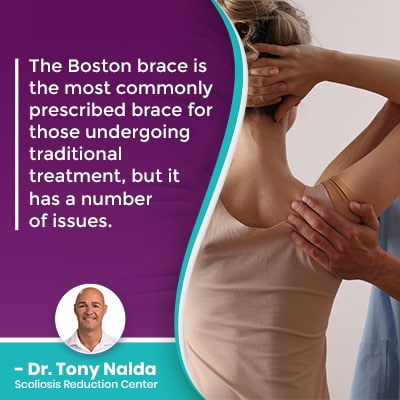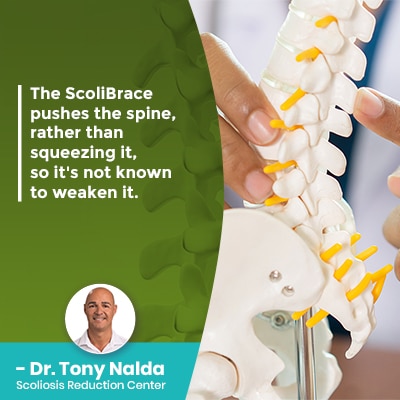Understanding Scoliosis Braces: Types, Uses, Effectiveness & More

There is more than one approach to treating scoliosis, both surgically and nonsurgically. Traditional treatment can funnel patients towards spinal fusion, while a modern conservative approach focuses on correction and increasing core strength; different treatment approaches favor different braces that are designed around the end goal of treatment.
Not all scoliosis braces are created equal. The Boston brace, used in traditional treatment, has stopping progression as its end goal; the ScoliBrace, used in conservative treatment, focuses on curve reductions. Different braces impact spinal health/function differently.
As the chosen treatment approach dictates the type of brace used, let's start our exploration of scoliosis braces, by first explaining the difference between the two main scoliosis treatment approaches.
Table of Contents
Scoliosis Treatment Approaches
Different scoliosis treatment approaches offer different potential outcomes, and patients need to make sure their expectations are aligned with the reality of how their spine can be affected.
As a progressive condition, scoliosis has it in its nature to worsen over time, which is why the chosen treatment approach is so important; only proactive treatment can counteract the condition's progressive nature.
Scoliosis ranges from mild to moderate and severe to very severe, and this is determined by what's known as a patient's Cobb angle.
A patient's Cobb angle tells me how severe the condition is, and how far out of alignment the spine is:
- Mild scoliosis: Cobb angle measurement of between 10 and 25 degrees
- Moderate scoliosis: Cobb angle measurement of between 25 and 40 degrees
- Severe scoliosis: Cobb angle measurement of 40+ degrees
- Very-severe scoliosis: Cobb angle measurement of 80+ degrees
There are two main scoliosis treatment approaches for patients to choose between: traditional and conservative.
Traditional Scoliosis Treatment Approach
Traditional scoliosis treatment tends to funnel patients towards spinal fusion surgery, quite simply, because it doesn't have an approach for treating scoliosis while mild, which is why it's described as reactive.
Those on the path of traditional treatment with mild scoliosis are most often told to watch and wait for further progression, but as a progressive condition, it's virtually guaranteed to get worse, so I see this as wasting valuable treatment time.
Patients are told to return at periodic intervals for assessment every 3, 6, to even every 12 months, and the problem with this is that growth is the condition's main trigger, and in the condition's most-prevalent form, adolescent idiopathic scoliosis, diagnosed between the ages of 10 and 18, this age group is at risk for rapid-phase progression.
So what happens if an adolescent has a significant growth spurt in between assessments, and experiences significant progression?
Now, their condition is more complex to treat, the spine becomes more rigid with progression, making it less responsive to treatment, and the body has had ample time to adjust to the unnatural spinal curve's presence.
In fact, prior to crossing into the severe classification, the only form of treatment applied is traditional bracing, most often at the moderate level, and traditional bracing is associated with a number of shortfalls.
If a patient's scoliosis becomes severe and shows signs of continued progression, at this point, patients are often told that spinal fusion surgery is the best remaining treatment option, and while it has its place in scoliosis treatment, it is a costly and invasive procedure that comes with some heavy potential risks and side effects.
There is also a big difference in working towards keeping a condition from getting worse, and actually working proactively to correct it.
Before getting to the specifics of these shortfalls, let's first explore the other main treatment option: conservative treatment.
Conservative Scoliosis Treatment Approach
For those wanting to forego a surgical recommendation, or who simply want to try a less-invasive form of treatment first, there is a modern conservative chiropractic-centered treatment approach that helps patients avoid the need for invasive spinal surgery.
Chiropractic-centered conservative treatment is what I offer patients here at the Scoliosis Reduction Center, and I believe in preventing progression, by reaching corrective results, through proactive treatment.
Here at the Center, I integrate multiple condition-specific treatment disciplines so the condition can be impacted on every level: chiropractic care, physical therapy for increasing core muscle strength so the spine's supported by its surrounding muscles, rehabilitation, and corrective bracing.
Through conservative treatment, corrective results mean the unnatural spinal curve is reduced in size by manually adjusting the position of the curve's most-tilted vertebrae back into alignment with the rest of the spine, the spine's surrounding muscles are strengthened so they can optimally support the spine, and custom-prescribed exercises help to establish a home-rehabilitation program for sustainable results and further stabilizing the spine.
When it comes to corrective bracing, we're talking about a brace that's designed to augment corrective results achieved through the aforementioned treatment disciplines, and just as the ultimate goal of conservative treatment is to achieve corrective results, corrective braces are designed around that same goal.
So now that we've touched on the two main scoliosis treatment approaches, let's move on to exploring the different brace options, starting with the Boston brace.
The Boston Brace
 The Boston brace is the most commonly prescribed brace for those undergoing traditional treatment, but it has a number of issues.
The Boston brace is the most commonly prescribed brace for those undergoing traditional treatment, but it has a number of issues.
The end goal of the Boston brace is to stop progression, and it does this through a 3-point system that applies pressure to strategic points of the unnatural curve, but it does this by squeezing the spine from the sides, which is known to weaken it over time.
In addition, scoliosis is the development of an unnatural sideways spinal curve, with rotation, making it a 3-dimensional condition, but the Boston brace only treats it as 2-dimensional, ignoring its rotational component and limiting its efficacy.
The Boston brace is mass produced, when it should be customized to address the specific curvature/body type, making it less comfortable to wear and causing compliance issues; oftentimes, the brace is prescribed for full-time wear, meaning anywhere from 18 to 23 hours a day, for up to five years.
While the Boston is the most common, traditional treatment can also include the prescription of a Milwaukee brace.
Milwaukee Brace
The Milwaukee brace is another traditional brace used primarily to address thoracic scoliosis.
There are three main spinal sections: cervical spine (neck), thoracic spine (middle/upper back), and lumbar spine (lower back).
The Milwaukee has a cumbersome design that extends from the neck down to the pelvis; there is also a neck ring and pelvic girdle connected by metal bars as long as the torso that help keep the head centered over the pelvis and torso.
It also squeezes the spine from the sides, like the Boston brace, and its end goal is also to stop scoliosis from progressing.
In addition to the Boston brace and the Milwaukee brace, there is also the Charleston bending brace, the Wilmington brace, and other nighttime braces that are associated with traditional scoliosis brace problems, but let's move on to how a corrective brace, like the ScoliBrace is different.
What Characteristics Make the ScoliBrace More Effective?
For a conservative treatment approach that focuses on achieving corrective results, the ultra-corrective modern ScoliBrace is favored, and it addresses many of the shortfalls associated with traditional bracing.
The ScoliBrace is designed to be more comfortable to wear, and less bulky, so compliance rates are better; any scoliosis brace is limited in its efficacy if it's not being worn exactly as it's prescribed.
The ScoliBrace represents the culmination of what's been learned about the condition over the years, and treatment efficacy, and for those asking, how will bracing affect my daily life, the answer will vary based on the type of brace wear in question.
The ScoliBrace uses state of the art computer aided design to scan and measure each patient so their brace is fully customized to address body/condition types and is designed to easily open and close in the front; in addition, the brace comes in a number of patterns so patients can further customize their choice.
Unlike traditional scoliosis braces, the ScoliBrace is designed to work on every level, addressing its rotational component so its true 3-dimensional nature is impacted.
 The ScoliBrace pushes the spine, rather than squeezing it, so it's not known to weaken it.
The ScoliBrace pushes the spine, rather than squeezing it, so it's not known to weaken it.
Regardless of how effective a scoliosis brace is, no brace on its own will be enough to treat scoliosis; it has to be integrated into a proactive treatment plan.
For those asking, can I do physical therapy instead of wearing a scoliosis brace, the answer is no one form of treatment is enough to impact scoliosis on every level; a corrective brace, like the ScoliBrace, can augment corrective results achieved through other forms of treatment.
Conclusion
There are a wide variety of scoliosis bracing options for patients to choose between such as the Boston brace, Milwaukee brace, the Wilmington brace, the rigo cheneau brace, and the modern corrective ScoliBrace, a custom brace.
Traditional braces are designed around the end goal of stopping progression, while a modern corrective brace is designed around augmenting corrective results achieved through a proactive conservative treatment plan.
Especially when full time bracing is prescribed, comfort is key as it fosters compliance, but as traditional braces aren't as customized as the ScoliBrace, they are less likely to be worn as they need to be, in terms of efficacy.
In addition, traditional braces are also associated with increasing condition-related postural deviation such as uneven shoulders and rib cage deformities.
Those on the path of conservative chiropractic-centered treatment benefit from an integrative approach that wants to achieve corrective results through chiropractic care, increasing muscle strength, rehabilitation, and corrective bracing that uses customization to ensure the brace fits comfortably.
So a brace based on achieving corrective results helps patients continue a healthy level of physical activity as they are more comfortable to wear, easier to move around in, improving posture, and complementing other forms of treatment for the best potential results.
Dr. Tony Nalda
DOCTOR OF CHIROPRACTIC
After receiving an undergraduate degree in psychology and his Doctorate of Chiropractic from Life University, Dr. Nalda settled in Celebration, Florida and proceeded to build one of Central Florida’s most successful chiropractic clinics.
His experience with patients suffering from scoliosis, and the confusion and frustration they faced, led him to seek a specialty in scoliosis care. In 2006 he completed his Intensive Care Certification from CLEAR Institute, a leading scoliosis educational and certification center.
About Dr. Tony Nalda
 Ready to explore scoliosis treatment? Contact Us Now
Ready to explore scoliosis treatment? Contact Us Now





